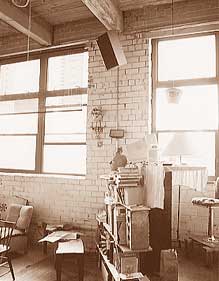In
the 1980s, the Seattle Empire Laundry would become another
kind of landmark: a pioneering instance of artists' housing.
Fondly known as "66 Bell", the old building housed
and entertained countless artists and visitors. Punk rock
concerts were played, record labels started, sound installations
presented, films made, theater staged, galleries housed and
open studios held inside its premises.
In
1997-1998, a group of the resident artists tried to stop its
transformation into condominiums by making a market-rate offer
for the building - which would have been preserved as artists'
studios, while being seismically retrofitted.
They
were helped by a Microsoft executive, the head of a local
law firm and the late, beloved Boston developer John McLaughlin.
McLaughlin brought to the proposal twenty years of work in
creating and preserving artists' housing - in Boston, his
extant work in that field includes the Brickbottom complex,
the Artist Tenants of the South End building and the celebrated
Laconia Lofts project.
The
owners of Seattle Empire declined to consider any offer. On
March 3, 1998, they submitted to the Department of Construction
and Land Use an eleven-paragraph Historical Background document
about the laundry.
This
inaccurately asserted that the building's original east entrance
no longer remained, claimed that "no historical photographs
are available", incorrectly asserted uniform interior
ceiling heights and cited the installation of a 1919 ramp
that was in fact never built. (The permit in question had
been mis-filed; it applied to a nearby department store property).
The
document also incorrectly asserted that the owner and developers'
plans for the building "do not call for exterior changes,
except to the north facade."
On
March 18, 1998, the Seattle Landmarks Board Coordinator submitted
document LPB 90/98 to the city's Department of Construction
and Land Use, stating that "it was unlikely that the
building at 66 Bell Street would meet the standards for landmark
status". Fifteen days later, the same official accepted
a landmark nomination for the building and set it to be heard
May 20, 1998.
That
day, the Landmarks Preservation Board issued a six-paragraph
Staff Report (LPB 161/98) that acknowledged the "extensive
research" presented in the nomination materials, yet
recommended that the Board decline to grant landmark status.
During
the May 20 nomination hearing, advocates hired by the owners
also vigorously opposed the landmark effort. They insisted
they would continue to do so.
Nomination
was granted; the designation hearing was set for July 1, 1998.
The landmark proponents made a legal request that discussion
of the building's historic features precede granting of any
permission to partially destroy it - via the granting of a
Certificate of Approval.
Nevertheless,
before designation arguments were heard, the owners were given
permission for such alterations. The
building was designated a Seattle landmark later that day,
in the early evening of July 1, 1998 (LPB 231/98). Officially,
its significant
features were to be preserved.
Many
people at the local, regional and national level supported
the building's nomination (see Landmark
Credits). Like the majority of contributors to the research
effort, almost none were ever residents in the building. The
Seattle Empire Laundry building, greatly
altered, is now a set of condominiums and rental units
known collectively as "Belltown Lofts".
|

